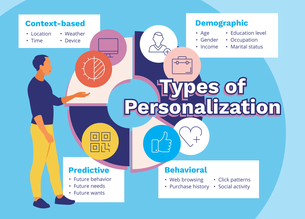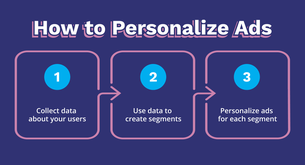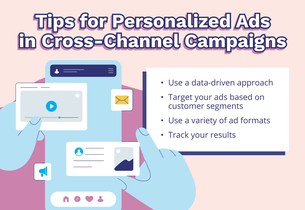What is Ad Personalization?
Ad personalization is the act of using customer insights to increase the relevancy of an ad to that specific person. These insights could be anything from demographic information to their specific interests, purchasing intent, and buying behavior.
Ad Personalization: A Beginner’s Guide.
If there’s one thing about online advertising that people hate, it’s seeing irrelevant ads.
Whether browsing social media, reading a news article, or watching videos on YouTube, seeing ads that don’t connect to your needs or lifestyle is annoying.
If you’re a brand that pays for advertising, you want to be sure that ad spend results in sales. So how do you reach the audiences who are most likely to buy?
As mentioned above, ad personalization uses customer insights to increase an ad’s relevance to a particular person. The insights available include basic demographic details, but they can also target specific interests, purchasing intent, and buying behavior.
Google, for example, considers an ad personalized when it uses previous or historical data to determine or influence the ads it shows users. That includes their previous search queries, site visits, demographics, location, etc.
Using data to create personalized marketing campaigns shows a commitment to understanding your customers and reaching them with appropriate messaging, no matter where they are in the sales process.
Effectiveness of Ad Personalization
While ad personalization could be controversial due to privacy concerns from consumers, it’s still an extremely powerful tool for marketers when it’s done right. Personalized ads remain a staple of the marketing toolkit, even as rules surrounding the collection and use of consumer data—like the European Union’s General Data Protection Regulation (GDPR)—evolve.
In fact, 72% of consumers said they would only engage with personalized marketing messages. In many cases, shoppers feel like ad personalization helps discover new products and reminds them to re-order products they have already purchased.
A study from Accenture provides even more context: 83% of consumers are willing to share personal information to allow brands to create personalized experiences.
Most online shoppers will share some personal details in exchange for discounts. According to Capterra, coupons prompt 85% of consumers to provide email addresses. Moreover, 70% will share their gender, and 60% give their names. Other types of personal information that people may hand over—although with more hesitation—include birthday (48%), occupation (43%), and home address (32%).
While consumers do have mixed feelings surrounding ad personalization—especially in European countries—they may tolerate it if it adds value to their shopping experience.
Where Does Personalized Ad Data Come From?
Brands use first- and third-party cookies to track individuals' online behavior. A cookie is a cute name for a small piece of code that follows you around the internet collecting data about the websites you visit, the products you look at, and the type of searches you conduct. It is also known as a pixel.
Online stores will use cookies to record visitors' information on the site. This includes login information, items in their shopping carts, and other preferences. Cookies help the company learn about its consumers and serve as a convenience for the shopper who would not want to re-enter information or start shopping whenever they revisit a site.
In addition to cookies that help retain customer information for later visits, brands often include cookies or pixels from their advertising platforms, such as Facebook or Google. These cookies help track ad performance and provide insights into user behavior that can help tailor future ads.
Types of Ad Personalization
How do personalized ads work? Brands have plenty of options for creating unique marketing experiences for their customers. Whether you’re trying to create personalized display or video ads, the following types of personalization can ensure your marketing message reaches the appropriate audience.

Demographic personalization
Demographic personalization refers to ads that specifically cater to demographic information about the target audience. Common factors for demographic personalization include, but aren’t limited to:
Age
Gender
Income
Education level
Occupation
Marital status
Curious about what this kind of targeting looks like in real life? Consider a luxury car brand that targets older, affluent demographics. In another example, a brand that sells trendy fashion might focus ads on younger age groups.
Note that some ads, like those for employment, housing, credit, and other financial products, may have their targeting and personalization restricted. You cannot exclude audiences for those ads based on age, parental status, or gender.
Behavioral personalization
When you personalize ads for specific behaviors, you target that content toward users' actions online. That includes web browsing, social media activity, and even items they purchase from other websites. Personalized display ads or other types of content might use the following behavioral insights:
Web browsing: The websites a user visits, individual pages they view, and the amount of time they spend on each page can help infer interests and intentions.
Purchase history: Because past purchases can indicate user preferences, they enable personalized product recommendations for similar or complementary goods.
Click patterns: The ads people click reveal a lot about their content or product preferences.
Social media activity: Likes, shares, comments, and follows on social media sites like Facebook, TikTok, and Instagram can provide insight into users’ interests, opinions, and brand loyalties.
Need a personalized advertising example based on behavior? Consider an individual who looks at a selection of knives on Amazon but they don’t buy anything. The Amazon advertising network might show this user more ads for knives on other websites or social media.
Context-based personalization
Capturing customers at an exact moment is increasingly important in digital marketing. Your audience’s situation can change in an instant. Context-based personalization allows you to reach your customers when it makes sense. The following examples of context-level personalization allow you an even more granular amount of control over when your ads appear:
Location-based: You can tailor your ads for users based on geographical location. Imagine you own a popular bistro that is a neighborhood lunch destination. You can show lunch specials to users who are nearby around that time.
Time-based: You and your audience may have different priorities based on the time of day, week, month, or even year. Imagine a coffee shop that promotes its morning brew during the earliest part of the day or a streaming service that heavily showcases ads for new movie premieres in the evening or on the weekend.
Weather-based: Companies can adapt ads based on current weather conditions. Clothing retailers, for example, might advertise a raincoat or umbrella during a rainy forecast. On the other hand, sunny weather in a user’s location might prompt ads for shorts and tank tops.
Device-based: Even a user’s device can play a part in personalizing ads. Sites could display differently on mobile devices versus desktop computers. Advertisers may want to optimize for screen size or functionality.
Predictive personalization
One final data-driven approach to personalization uses algorithms and machine learning to predict customers’ future behavior, needs, and wants. This predictive personalization relies heavily on consumer data to then share tailored offers, products, or messages to those audiences across different channels and touchpoints. It is not manual segmentation, however. Machine learning and AI handle the legwork.
In practice, this kind of personalization involves the following process:
Data collection: Pull data about customers’ past behaviors, interactions, purchases, and any other relevant factors.
Data analysis: Algorithms and machine learning models analyze the data and identify patterns or trends.
Prediction: After analyzing the data, the system makes predictions about what a customer is likely to do, want, or need in the future.
Personalization: With predictions in hand, the model creates personalized content, offers, and recommendations for the customer.
Need an example? Imagine a customer who frequently buys a particular product type, such as shampoo formulated for curly hair. Predictive personalization might analyze that purchase and serve ads for other relevant products they’re likely interested in, like special conditioners.
Retargeting
Retargeting is one of the most effective forms of personalized ads. It is effective at overcoming the fact that most shoppers will not purchase during their first website visit.
Instead, they may shop around, compare prices, place a few items in the cart, and then leave. Cart abandonment—as this behavior is called—can signify a consumer’s dissatisfaction with the checkout process or shipping cost or their intent to compare prices between multiple websites. Or they may just be browsing at work and shut the window before their boss can see.
Whatever the reason, retargeting helps companies reach out to those consumers—nearly everywhere on the web. Brands can utilize dynamic ads that show users personalized ads based on their browsing history on your website and items they left in their shopping carts.
By staying in front of the consumer on social media, throughout the Google Display Network (GDN), and even in emails, they will not likely forget about the items they left behind. Your brand is also top-of-mind when they are ready to make a purchase.
How to Personalize Ads

So you’re ready to personalize ads for your customers but are unsure how to get started. With the following process, you can build a segmented cross-channel marketing campaign .
1. Collect data about your users
Personalization doesn’t work without customer data. You can't effectively reach your target audiences if you don’t know anything about them. Leverage your resources to collect information.
Website analytics tools provide valuable behavioral insights, including how people get to your website, what they click on, and how much time they spend on each page. Cookies and tracking pixels allow you to track their activity across other sites. Even social media platforms can give you a detailed—if still relatively anonymous—glimpse of who your customers are and what interests them.
Of course, you can also just ask for details outright. Surveys and feedback forms let customers share personal information and what they think, and the right CRM gives you a place to store that information. Data unification helps you manage that information in one place and ensures the details therein are correct.
Customer data is a powerful tool. Be transparent about how and why you collect and use it to earn and maintain customers’ respect.
2. Use data to create segments
The data you collect and store allows you to build segments for every marketing campaign you’ll use in the future. Customer segmentation falls along many of the same lines as ad personalization. You can group customers by website and social media behaviors, interests, demographics, purchasing behavior, etc.
3. Create personalized ads for each segment
Once you have appropriate segments, you can create personalized ad content for each one. Each ad type and segment may require unique messaging, ad creative, coupons or offers, and even messaging timing. Once you know which types of marketing messaging resonate with each segment, you can create an appropriate media mix to reach them.
4 Tips for Leveraging Personalized Ads for Cross-Channel Campaigns
Personalization isn’t just for single campaigns. It’s a powerful way to maximize the impact of your cross-channel marketing efforts. Omnichannel personalization allows you to reach customers with highly specific, tailored messaging no matter what stage of the buying process or channels they choose to interact with you.
Many of the same principles that apply to personalizing a single ad campaign are relevant to multichannel campaigns. In fact, scaling your marketing efforts from one type of campaign to another is one of the best ways to reach multiple segments at once. Data-driven marketing can help you uncover which campaigns—and audiences—make the most sense for your brand, and tracking results will help you lower your marketing costs for the next campaign. Let’s walk through some of the best tips for cross-channel marketing efforts:

Use a data-driven approach
No matter how creative you are with your marketing strategy, using data to inform your decision-making is better than pure vibes. Customer data lets you see messaging preferences and know what kinds of CTAs, ad headlines, and images resonate the most with your customers.
Using A/B testing to change one element at a time allows you to experiment and gives you insights for future campaigns.
Target your ads based on customer segments
Your customers deserve better than a one-size-fits-all advertising approach. Tailor your ads to specific customer segments. To help with segmentation, consider using your buyer personas as a starting point. You can also use survey information to glean first-party insights and tap into the power of your CRM.
Use a variety of ad formats
The beauty of cross-channel campaigns is that you can use several ad formats to reach customers where they spend time online. Using personalized ads on social media allows you to put your products and message in front of potential customers on several platforms at once. Personalized video ads can run on platforms like Instagram and YouTube.
Track your results
You can run as many ads as you like, but tracking their performance allows you to know what’s working well and what isn’t. Instead of throwing money at campaigns with low open rates or CTR, use your budgets efficiently by closely watching each campaign and channel. If one is underperforming, cut back on spending or test alternate headlines or ad copy.
Get Started With Personalized Ads
With all the right data, you’re ready to begin your ad personalization efforts. Whether you’re sending out personalized emails or unique display or social ads, remember the following best practices:
Know where users are in the funnel, what pages or products they viewed on your site, and basic demographic data (Gender, Geography, Industry).
Decide on elements you want to personalize within your ads. For example, if the user visited a certain product page but did not convert, you might show them a display ad with that same product they considered buying.
Finalize the KPIs you’ll measure for campaign success. These could be converted sales, MQLs, additional visits to your site, or various other conversions.
When these elements are determined, you can move to the creative development phase of the campaign. In this step, you’ll work with writers, video editors, social media pros, and designers and/or web developers to create the ads you’ll run.
Once your ad creative and targeting are finalized, you’ll be ready to launch the campaign! If you need additional help with campaign optimization for your cross-channel marketing efforts, an all-in-one solution can streamline that process. AdRoll’s digital advertising platform enables you to deploy, measure, and re-optimize ad personalization campaigns.
FAQ
Why is personalized advertising important?
Personalized advertising allows you to tailor your marketing message to individual interests, needs, and preferences. It creates more engaging experiences for your customer. This leads to an improved customer experience, higher conversion rates, and boosted brand loyalty as customers feel seen.
How are personal ads created?
You can create personal ads for your audiences by using collected data to segment them appropriately by location, interests, demographics, and more. Personalization strategies can include showing different ad creative, headlines, promotions, and even campaign types.
How effective is personalized advertising?
Studies have shown that customers want advertising that caters to their interests, location, and behavior. 29% of 1,000 survey participants say they’d be more likely to purchase based on a personalized ad.
What are the benefits of having a more personalized approach to advertising?
Adopting a personalized advertising approach enhances customer engagement as the ads resonate with your audiences and customers. Because happy customers tend to stick with a brand, it also aids in customer retention and increased conversions. Personalized ads are more effective and often lead to a better ROI. In short, personalized ads lead to more meaningful customer interactions, improved business outcomes, and stronger brand reputations.